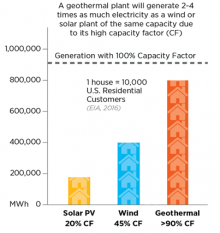Renewable energy projects can’t get off the ground without power purchase agreements (PPAs), so when a new geothermal PPA gets signed, a geothermal star is born. Learn more about PPAs in this three-part blog series.
Office of Critical Minerals and Energy Innovation
February 1, 2022An Energy Story in Three Chapters
Catch up by reading Chapter 1, and read Chapter 3!
Among numerous highlights in the National Renewable Energy Laboratory’s recently published Geothermal Power Production and District Heating Market Report, one in particular stands out: since 2019, 11 new geothermal power purchase agreements have been signed across four states. This is a big deal in renewable energy circles, but why should it matter to us, the energy consumers across the country?
Power purchase agreements are the contracts that allow utilities to procure electricity from power plants. These agreements help determine how much you ultimately pay for the electricity that charges your phone, fires up your television on game day, lights your home, and, in general, powers your life.
Lights, camera, ACTION ….
Geothermal Takes the Stage
Extreme weather events and energy shortages in western states have added a fresh sense of urgency to the development of renewable energy. As states like California look to improve their balance of supply and demand, ensuring they can meet the needs of their constituents even in moments of crisis, the stability of geothermal power purchase agreements (PPAs) offers an attractive solution.
Among renewable power sources, geothermal energy delivers the highest capacity factor—or the best ratio of actual energy output to possible energy output—because it does not rely on favorable weather conditions. With grid reliability a concern, the California Public Utilities Commission specified, in an historic procurement order issued in June 2021, development of 11,500 megawatts of new capacity by 2026, including 1,000 megawatts of renewable generation at 80% percent or greater capacity factor and no on-site emissions. Modern geothermal power plants deliver a capacity factor upwards of 90-95%.
Two new geothermal power plants are joining or near to adding to the nation’s electricity supply: Casa Diablo IV (30 MW), part of the Mammoth Geothermal Complex near Mammoth Mountain, and the under-development Hell’s Kitchen (50 MW) in the Salton Trough of southern California.
The Casa Diablo IV PPA will deliver 14 megawatts (MW) of power to Bay Area communities via Central Coast Community Energy (CCCE) and Silicon Valley Clean Energy (SVCE),[1] and 16 MW to Colton, California, (pop. 54,000) a suburb of San Bernardino in the state’s Inland Empire region.
The $1.8 billion Hell’s Kitchen Geothermal Power and Lithium Extraction Facility is part of a 25-year PPA signed in 2020 between operator Controlled Thermal Resources (CTR) and the Imperial Irrigation District (IID) in Imperial Valley, California.[2] According to CTR, the project will create several hundred onsite jobs during construction and 180 operations and maintenance jobs once the plant is up and running.
Slated to begin operations in 2024, CTR has an agreement in place with General Motors, a lead investor in the project, to provide lithium hydroxide and carbonate for use in production of electric-powered vehicles. This battery-grade lithium will be extracted during the geothermal brine cycling process. General Motors anticipates increasing demand for both current applications, e.g. cathode and electrolyte systems, and expanded future uses, such as the development of lithium metal batteries.
Adding even more geothermal power to address California’s urgent grid needs, Ormat Technologies last quarter closed on its first-ever “reverse auction” that saw the company publish a bid solicitation for its Heber 2 geothermal power plant in Heber, California. This is just one example of where California is looking for renewables for their grid. “Interest in geothermal power in California is the highest we’ve ever seen,” noted Paul Thomsen, head of business development at Ormat. “There’s a sense of urgency to add more geothermal, largely because of its unrivaled capacity factor and baseload capability.”
............................
[1] CCCE and SVCE to date have signed 12 joint PPAs totaling 1,470 MW of energy and 356 MW of storage.
[2] The current conventional geothermal resource estimate for the Salton Sea Geothermal Field, adjacent to Imperial Valley, is 2950 MWe: Kaspereit, D. et al. 2016. “Updated Conceptual Model and Reserve Estimate for the Salton Sea Geothermal Field, Imperial Valley, California.” Geothermal Resources Council Transactions, 40, 57-66. Imperial Valley is a major agricultural region near the Salton Sea, located about 30 miles north of the Mexico border; annual crop production exceeds $1 billion. The Imperial Valley also includes several geothermal facilities in Mexico.


